Guar Gum Market Overview:
The global guar gum market is steadily growing, driven by rising demand in industries such as food and beverage, pharmaceuticals, oil and gas, and textiles. Guar gum is used in a variety of applications, including food additives, hydraulic fracturing (fracking), and industrial thickening agents. Our paper provides a detailed examination of procurement trends, with a focus on cost-cutting techniques and the use of innovative digital solutions to expedite procurement and manufacturing processes.
Key future challenges for the guar gum market include managing fluctuating raw material costs, guaranteeing continuous supply chain efficiency, maintaining product quality, and dealing with environmental problems. The use of modern digital procurement technologies and strategic sourcing methodologies is critical for optimising guar gum sourcing and guaranteeing long-term sustainability. As worldwide demand for guar gum grows, businesses are using market intelligence to improve operational efficiency, mitigate risks, and preserve a competitive advantage.
- Market Size: The global Guar Gum market is projected to reach USD 19.84 billion by 2035, growing at a CAGR of approximately 4.9% from 2025 to 2035
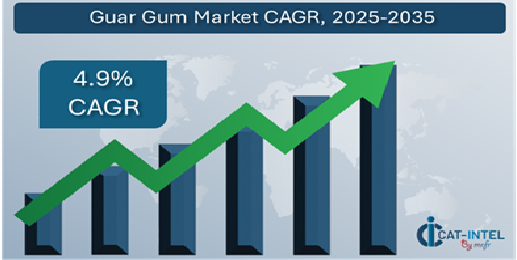
Growth Rate: 4.9%
- Sector Contributions: Growth in the market is driven by:
- Manufacturing and Supply Chain Optimization: Real-time data and optimized processes are crucial for optimizing production and distribution of guar gum due to rising demand.
- Food and Beverage Growth: Food and beverage companies use technology to manage inventory, estimate demand, and improve customer connections, leading to stronger supply chains and consistent product availability.
- Technological Transformation: Advancements in technology, including AI and machine learning, are improving the functionality of guar gum applications, especially in industries like oil and gas where it is utilized for hydraulic fracturing.
- Innovations: Flexible sourcing approaches allow manufacturers to select certain grades of guar gum based on their requirements, which improves cost control and reduces complexity.
- Investment Initiatives: Companies are investing in sustainable procurement of guar gum to lower their carbon footprint and assure a reliable supply.
- Regional Insights: North America and Asia Pacific are the fastest growing regions for guar gum due to their strong industrial bases, enhanced manufacturing capabilities, and increasing demand across various sectors.
Key Trends and Sustainability Outlook:
- Sustainability Focus: The guar gum sector prioritizes sustainability, including environmentally friendly farming processes and sustainable sourcing.
- Cloud Integration: Guar gum suppliers are increasingly using cloud-based systems to manage production, inventory, and shipping, as seen in other industries.
- Advanced Features: Integrating cutting-edge technologies such as blockchain and IoT into the guar gum supply chain ensures traceability, transparency, and better decision-making.
- Customization: Guar gum products suited to specific industries, like pharmaceuticals and personal care, are in high demand. Companies might use these tailored solutions to satisfy specific market requirements.
- Data-Driven Insights: Data analytics is crucial in the guar gum industry, enabling precise demand forecasting, production optimization, and monitoring of market changes.
Growth Drivers:
- Data Transformation: Guar gum providers and producers are incorporating digital solutions to improve productivity, optimize resource utilization, and respond to market demands.
- Demand For Process Optimization: Automated methods enable production lines to fulfil expanding demands without compromising quality or consistency.
- Scalability Needs: Businesses in areas such as oil extraction and food production want guar gum suppliers who can quickly scale output to meet shifting demand.
- Regulatory Compliance: Guar gum companies must automate and implement quality control systems to meet regulatory requirements for food safety, environmental standards, and ingredient sourcing.
- Globalization: Growing demand for hydraulic fracturing necessitates consistent and compliant guar gum products in many currencies and languages, enabling providers to enter new worldwide markets.
Overview of Market Intelligence Services for the Guar Gum Market:
Recent research has identified important issues in the guar gum market, including growing raw material costs and the need for improved supply chain management. Market intelligence studies give meaningful data to help businesses identify cost-cutting initiatives, optimize supplier relationships, and improve operational procedures. These insights are critical for sustaining high-quality manufacturing standards while successfully managing costs, ensuring that businesses can navigate difficulties and seize chances for growth.
Procurement Intelligence for Guar Gum: Category Management and Strategic Sourcing
To remain competitive in the guar gum industry, businesses are refining their procurement strategies through expenditure monitoring and supplier performance tracking. Effective category management and strategic sourcing are critical for lowering procurement costs while maintaining a consistent supply of high-quality guar gum products. Businesses can improve their procurement strategies by leveraging meaningful market intelligence for better terms with suppliers and find a dependable and affordable source of guar gum. This allows organizations to improve supply chain resilience, increase manufacturing efficiency, and remain competitive in an expanding global market.

Pricing Outlook for Guar Gum: Spend Analysis
The price prognosis for guar gum is likely to be moderately volatile, affected by a variety of factors. Raw material cost fluctuations, rising demand in a variety of industries (including food, pharmaceuticals, and oil extraction), and regional pricing variances are all major drivers. Furthermore, rising demand for sustainable sourcing and improved processing methods, together with tighter controls on product quality and environmental effect, are expected to put upward pressure on guar gum cost.
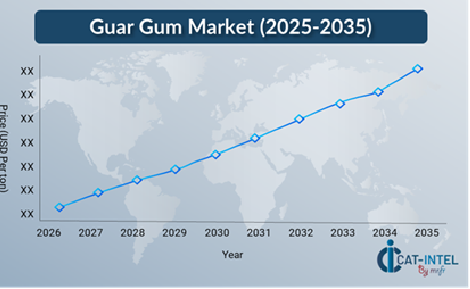
Graph shows general upward trend pricing for Guar Gum and growing demand. However, there may be fluctuations influenced by economic conditions, technological advancements, and competitive dynamic.
Efforts to streamline procurement procedures, improve supplier management, and use flexible sourcing strategies are crucial for cost reduction in the guar gum industry. Leveraging digital solutions for market monitoring, forecasting price trends using data analytics, and efficient contract administration can help businesses better anticipate price swings and improve procurement efficiency.
Partnering with reputable guar gum suppliers, negotiating long-term contracts, and exploring flexible pricing structures are all useful cost-cutting techniques. Regardless of issues such as fluctuating raw material costs, focusing on supply chain resilience, introducing innovative processing processes, and embracing sustainable sourcing practices will be critical to maintaining cost-effectiveness and assuring a consistent supply of high-quality guar gum.
Cost Breakdown for Guar Gum: Total Cost of Ownership (TCO) and Cost-Saving Opportunities

- Raw Materials: (40%)
- Description: The key cost driver for guar gum procurement is raw material cost, which comprises the price of guar seeds, their quality, and the harvesting method.
- Trends: Raw material costs for guar gum are heavily impacted by crop output and weather conditions, resulting in significant market price volatility.
- Processing and Production: (XX%)
- Logistics and Transportation: (XX%)
- Quality Control and Compliance: (XX%)
Cost-Saving Opportunities: Negotiation Levers and Purchasing Negotiation Strategies
In the guar gum sector, streamlining procurement techniques and using successful negotiation tactics can considerably cut costs while increasing operational efficiency. Long-term relationships with dependable suppliers, particularly those who provide sustainable and constant sources of guar gum, can lead to more attractive price arrangements. Volume-based discounts, flexible pricing methods, and bundled service agreements can all assist businesses manage variable expenses.
Long-term contracts or subscription-based arrangements with guar gum suppliers can help to ensure reduced rates while also protecting against potential price hikes. Collaborating with suppliers who value innovation, such as sophisticated processing processes and sustainable farming practices, can provide additional benefits. These include access to more efficient production methods and enhanced quality control, which will eventually lower operational costs and increase product consistency.
Supply and Demand Overview for Guar Gum Demand-Supply Dynamics and Buyer Intelligence for Effective Supplier Relationship Management (SRM)
The guar gum market is also expanding steadily, driven by rising demand from industries such as food & beverage, pharmaceuticals, and oil and gas. Technological improvements, industry-specific needs, and overall economic conditions all have an impact on guar gum supply and demand.
Demand Factors:
- Rising Demand for Functional Ingredients: Guar gum's rising use as a crucial ingredient in a variety of applications, including food, hydraulic fracturing, and pharmaceuticals, is boosting demand across many industries.
- Sustainability Trends: As people become more aware of sustainable sourcing and production techniques, there is a greater demand for guar gum from organizations that value environmental responsibility and ethical sourcing.
- Industry-Specific Requirements: Different industries, including oil and gas, food processing, and pharmaceuticals, require guar gum modified to fulfil specific standards, such as viscosity control.
- Integration of Advanced Processing Technologies: Guar gum's ability to integrate efficiently with other chemicals and formulations in a variety of applications, such as fracking fluids or food items, is becoming increasingly important, necessitating more sophisticated manufacturing and supply chain systems.
Supply Factors:
- Advancements Processing Technologies: Innovations in farming techniques, crop yields, and processing technologies are increasing guar gum availability.
- Vendor Ecosystem: With an increasing number of suppliers, including both large-scale producers and smaller, specialized vendors, consumers have more alternatives for purchasing guar gum based on quality, price, and sustainability preferences.
- Global Economic Factors: Exchange rates, labour cost fluctuations, and regional variations in technology adoption all have an impact on guar gum pricing and availability.
- Scalability and Flexibility: Modern guar gum manufacturing systems, like the ERP software industry, are becoming more adaptable and scalable, allowing producers to meet the unique requirements of industries of varied sizes and complexities.
Regional Demand-Supply Outlook: Guar Gum
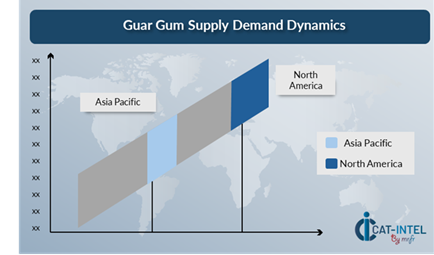
The Image shows growing demand for Guar Gum in both North America and Asia Pacific, with potential price increases and increased Competition.
North America: Dominance in the Guar Gum Market
North America, particularly the United States, is a dominant force in the global Guar Gum market due to several key factors:
- High Demand in the Oil and Gas Industry: Guar gum is a vital element in fracturing fluids, which are used to extract oil and gas from shale formations.
- Food and Beverage Applications: Rising consumer demand for natural, plant-based, and gluten-free meals has fuelled the expansion of guar gum consumption in North America, making it an important market for providers.
- Pharmaceutical and Cosmetics Demand: The region's significant healthcare and beauty sectors are driving this demand, as consumers seek natural and safe ingredients in personal care goods.
- Established Supply Chain: North America has a well-established and efficient supply chain and logistics infrastructure, making it easier to import and distribute guar gum.
- Technological Advancements: Guar gum is widely adopted due to research and development in adapting it for specialized purposes in industries such as food, medicines, and oil and gas.
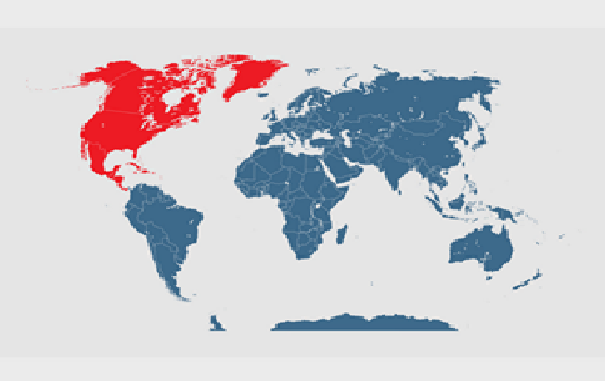
North America Remains a key hub Guar Gum Price Drivers Innovation and Growth.
Supplier Landscape: Supplier Negotiations and Strategies
The supplier landscape in the guar gum market is equally diversified and competitive, with both global and regional vendors shaping market dynamics. These suppliers have a significant impact on pricing patterns, quality control, sourcing techniques, and delivery dates. Established producers in major growing regions, such as India, are the market leaders in guar gum production, while smaller, niche suppliers cater to specific industries or offer unique product types tailored to specialized applications such as food additives, fracking, and pharmaceuticals.
The guar gum supplier ecosystem includes both large-scale producers and regional businesses, with an emphasis on quality, sustainability, and innovation. As industries prioritize sustainability, cost optimization, and operational efficiency, suppliers are investing more in efficient processing technology, sustainable farming methods, and more supply chain transparency. These developments enable suppliers to offer competitive pricing, maintain consistent delivery, and meet specific quality criteria across multiple industrial sectors.
Key Suppliers in the Guar Gum market include:
- Cargill Corporation
- Ingredion Incorporated
- Vikas WSP Limited
- Kashmir Chemicals
- Shree Gajanan Industries
- Jai Bharat Gum and Chemicals.
- Hindustan Gum and Chemicals.
- Raj Gum Pvt. Ltd.
- Epsilon Carbon.
- Global Gums and Chemicals.
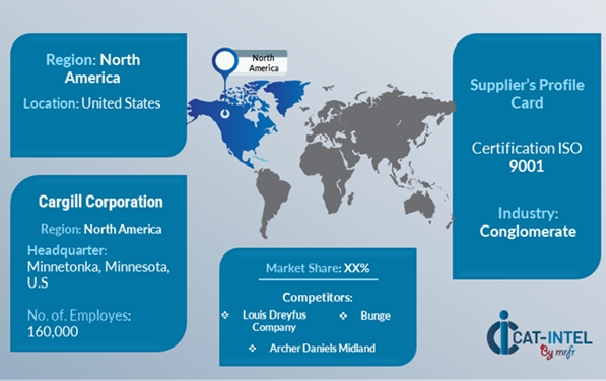
Key Developments Procurement Category Significant Development:
|
Significant Development |
Description |
|
Market Growth |
The guar gum market is expanding rapidly, driven by rising demand from industries such as food and beverage, pharmaceuticals, oil and gas, and textiles. As businesses seek natural and sustainable thickening, stabilizing, and gelling agents, global demand for guar gum is increasing, particularly in emerging economies. |
|
Cloud Adoption |
Sustainable and ethical sourcing techniques are becoming increasingly important in the guar gum sector. Consumers and businesses are becoming more aware of environmental concerns, causing producers to embrace sustainable agricultural and production practices, resulting in growth in markets that value environmental responsibility. |
|
Product Innovation |
Guar gum producers prioritize product innovation to fulfill the changing needs of various industries. High-quality guar gum grades have been developed to provide excellent performance in food, medicines, and oil extraction. |
|
Technological Advancements |
Technological improvements, including precision farming and extraction processes, are improving guar gum production capacity. Biotechnology innovations, IoT integration for agricultural monitoring, and AI-powered analysis of yield data, are enhancing efficiency and maintaining stable supply, even in the face of changing environmental conditions. |
|
Global Trade Dynamics |
Global trade dynamics, including trade restrictions, compliance requirements, and regional economic strategies, are impacting the guar gum industry, especially in important producing countries such as India. Tariffs, labor costs, and international trade agreements can all have an impact on the price and availability of guar gum, particularly for multinational corporations with complex supply chains. |
|
Customization Trends |
Guar gum providers are offering customized goods to fulfill industry-specific criteria, such as food safety certifications and viscosity levels for fracking applications. The shift toward flexible, specialized sourcing alternatives enables businesses to meet their specific needs while increasing cost efficiency and product performance. |
|
Guar Gum Attribute/Metric |
Details |
|
Market Sizing |
The global Guar Gum market is projected to reach USD 1984.71 billion by 2035, growing at a CAGR of approximately 4.9% from 2025 to 2035. |
|
Guar Gum Technology Adoption Rate |
Approximately 70% of guar gum producers and suppliers have implemented sophisticated technology solutions to improve yield, processing efficiency, and supply chain management. |
|
Top Guar Gum Industry Strategies for 2025 |
As the demand for eco-friendly products rises, many producers are focused on more sustainable agricultural practices and novel processing technologies to enhance guar gum supply while reducing environmental footprint. |
|
Guar Gum Process Automation |
The production of specific guar gum grades for industries such as food, pharmaceuticals, and fracking is increasing. Incorporating technological developments throughout processing guarantees that the finished product fulfils industry standards. |
|
Guar Gum Process Challenges |
The use of data analytics and artificial intelligence (AI) to forecast demand, monitor supply chain performance, and improve inventory management increases efficiency and reduces waste. Inventory management, quality control, and shipping tracking are some of the key activities being automated.
|
|
Key Suppliers |
Global suppliers including Cargill Corporation, Ingredion Incorporated, Vikas WSP Limited and Lucid Group, serve a variety of industries, including oil and gas, food production, and pharmaceuticals, and are increasingly using digital platforms for procurement and production management.
|
|
Key Regions Covered |
Guar gum is becoming increasingly popular in North America, Europe, and Asia-Pacific industries such as food and beverage, pharmaceuticals, and hydraulic fracturing. |
|
Market Drivers and Trends |
The demand for natural, sustainable components is driving the expansion of guar gum in a variety of industries. Guar gum is becoming increasingly popular in food and industrial applications as emerging economies, particularly Asia and Africa, industrialize.
|
Frequently Asked Questions (FAQ):
Our procurement intelligence services offer in-depth market analysis of guar gum suppliers, including key producers and regional market dynamics. We provide spend analysis, supplier evaluations, and sourcing strategies to help secure competitive prices and ensure a consistent, high-quality supply of guar gum for various industries.
We assist in assessing the TCO for guar gum by considering raw material costs, transportation fees, storage expenses, and potential fluctuations in pricing. This comprehensive analysis ensures a clear understanding of the overall financial impact of sourcing guar gum, especially in light of global supply chain volatility.
Our risk management services address challenges such as fluctuations in raw material prices, supply chain disruptions, and regulatory compliance issues. These strategies help mitigate risks, ensuring a stable and cost-effective procurement process for guar gum.
Our Supplier Relationship Management (SRM) services focus on cultivating long-term partnerships with guar gum suppliers. We help negotiate favorable terms, track supplier performance, and ensure consistent quality and delivery timelines to optimize the supplier relationship.
We recommend best practices such as vendor segmentation, cost-benefit analysis, and ensuring compliance with industry standards. These practices help organizations source guar gum effectively, ensuring quality and competitiveness while optimizing procurement costs.
Digital tools optimize guar gum procurement by automating supplier selection, monitoring price trends, and improving supply chain visibility. These tools help reduce operational costs, minimize risks, and improve procurement efficiency by providing real-time data and forecasts.
Our supplier performance management services monitor key metrics such as delivery times, product quality, and responsiveness. This ensures that guar gum suppliers consistently meet your requirements and helps evaluate supplier reliability for future procurement decisions.
We support negotiations by utilizing market intelligence, benchmarking pricing, and employing strategies like long-term contracts and volume-based discounts. These approaches help secure favorable pricing and terms with guar gum suppliers, ensuring cost-effective procurement.
We offer tools that provide detailed insights into market trends, supply chain forecasts, and regional price fluctuations for guar gum. These resources empower data-driven decisions, helping businesses select the best suppliers and optimize their procurement strategies.
We help ensure compliance with industry regulations by verifying that guar gum suppliers meet required quality standards, sustainability certifications, and legal requirements. This supports adherence to environmental and safety regulations throughout the procurement process.
We recommend diversifying supplier sources, maintaining buffer stock, and working with flexible suppliers who can adapt to changing demand and supply conditions. These strategies help reduce risks of supply chain disruptions and ensure uninterrupted access to guar gum.
Our tracking solutions monitor key performance indicators such as product quality, on-time delivery, and supplier communication. This allows you to assess the reliability of your guar gum suppliers and make informed decisions for future procurement.
We identify suppliers who prioritize sustainable farming practices, eco-friendly packaging, and energy-efficient production methods. By sourcing from these suppliers, businesses can align with their sustainability goals while maintaining high-quality guar gum supply.
Our pricing analysis compares vendor rates, tracks market trends, and applies negotiation tactics to help secure competitive pricing for guar gum. We ensure that you achieve cost-effective procurement while maintaining product quality and supply consistency.
We assist in identifying suppliers that focus on sustainable production methods, such as using eco-friendly farming practices, reducing water usage, and utilizing organic certifications. By partnering with such suppliers, businesses can minimize the environmental impact of their guar gum procurement, align with sustainability goals, and meet consumer demand for environmentally responsible sourcing.








